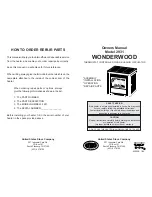
5 minutes, and repeat the lighting
procedure. If built-in ignitor will
not light follow the preceding steps
and hold a lit long igniter to match
next to the burner when opening the
control valve.
If the flame is accidentally
extinguished, turn the appliance
valves OFF and WAIT 5 minutes
before attempting to ignite.
Burner Flame Check
• Light burner; rotate knob(s) from
HIGH to LOW. You should see
a smaller flame in LOW position
than seen on HIGH. Always check
flame prior to each use. A good flame
should be blue with minimal yellow
tip. Some yellow tips on flames are
acceptable as long as no carbon or
soot deposits appear.
Turning LP Cooker Off
• Turn all knobs to OFF position.
Turn LP tank OFF by turning hand-
wheel clockwise to a full stop.
Hose Check
• Before each use, check to
see if hoses are cut or worn. Replace
damaged hose assembly before using
appliance. Use only valve/ hose /
regulator specified by manufacturer.
See product sheet for hose & regulator
information.
Cleaning The Burner
NOTE: Spiders and small insects can
spin webs and build nests inside the
CAUTION
All cleaning and maintenance
should only be done when the
appliance is cool and with the fuel
supply turned off at the LP cylinder.
DO NOT clean any part in a self-
cleaning oven. The extreme heat
will damage the finish.
burner. This especially occurs in late
summer and fall before frost when
spiders are most active. These nests
can obstruct gas flow and cause a fire
in and around the burner and orifice.
Such a fire can cause operator injury
and serious
damage to the
appliance. To
help prevent a
blockage and
ensure full heat
output, clean and
inspect burner
tube often (once or twice a month).
NOTE: Water or air pressure will not
normally clear a spider web.
Steps for cleaning the Burner:
1.
Remove burner assembly from
burner.
2. Look inside the burner tube for
nests, webs, or mud.
3. To remove the above obstructions,
use an accessory flexible venturi
brush or bend a small hook on one
end of a long flexible wire or use an
air hose.
4.
Inspect and clean the burner
if needed.
5. When assembling the burner back to
the stove, the proper location of the
burner with respect to the orifice is
important. The burner tube must be
located over the brass orifice fitting.
Cleaning and Maintenance
Correct care and maintenance will keep
your appliance operating smoothly.
Clean regularly as determined by the
amount of use. NOTE: Clean the
entire appliance each year and tighten
all hardware on a regular basis (1-2
times a year or more depending on
usage). Cleaning should be done where
detergents won’t harm patio, lawn, or
the like. Keep appliance area clear
and free from combustible materials,
gasoline and other flammable vapors
and liquids. Keep the ventilation
opening(s) of the cylinder enclosure
free and clear from debris.
Suggested Cleaning Materials
• Mild dish washing liquid
detergent
• Wire brush
• Nylon cleaning pad
• Hot water
• Paper clip
• Soft brass bristled brush
Component Cleaning:
• Burner should be wiped clean. Hot
soapy water and a soft bristle brush
can be used to clean the burner
surfaces. Clean clogged gas port holes
with an opened paper clip. Replace
corroded or damaged burners that
would emit excess gas.
• COOKING SURFACES, POTS
AND PANS: Clean the cooking
surface with soapy water and a nylon
cleaning pad.
• After appliance has cooled, wipe
areas where paint and finish have
burned off to minimize rusting.
Using a thermometer
Prior to lighting, position
thermometer clip so that at least 1/2”
of thermometer tip is submerged
in oil. Reposition thermometer
as necessary to cook. Continue to
use thermometer until burner is turned
off.
If Frying:
• Follow instructions provided by the
appliance manufacturer.
• When cooking with oil or grease, a
thermometer must be used.
• Introduction of water from any source
into the cooking oil or grease may
cause overflow and severe burns from
hot oil and water splatter. When frying
with oil and grease, all food products
MUST be completely thawed and
towel dried to remove water before
being immersed in the fryer.
• Be sure thermometer is in good
working condition. To check the
thermometer, insert it into a pot
of boiling water and ensuring that
it registers approximately 212°F
± 20°F (100°C ± 10°C). If it does
not function properly, obtain a
replacement thermometer specified
by the manufacturer before using the
appliance.
• Do not over fill the pot with cooking
liquid. Never fill appliance more than
half full of cooking liquid or past
the maximum fill line (a permanent
marking on fryer).
• If cooking liquid has spilled
and ignited, do not attempt to
extinguish with water. Immediately
turn gas supply OFF at the supply
cylinder and:
• Extinguish flames using a BC type
fire extinguisher as recommended
by the fryer manufacturer; or
smother flames with dirt or sand.
• In case there is a fire, call the
local fire department or dial 911.
0312-Coven-TriBook.indd 12-13
3/22/12 4:29 PM








































